Introduction
The practice of medicine is both art and science. At Bristol Medical School, we seek to create learning opportunities to support our students to develop in both of these complementary domains. Alongside learning the biomedical and social science principles of medicine, our students meet real patients from the start. Their consultation skills training places patients at the centre of each encounter (Thompson et al., Citation2021). In a novel aspect of our course, we also draw students towards the human dimension through engagement with the creative arts.
Creativity is one of the core values of our consultational approach. Though medicine is not typically considered a creative discipline, we argue that fresh thinking is key to helping patients unlock complex health problems (Ten Haven et al., Citation2022). The creative arts bring the additional demand of close and considered observation, a skill directly transferable to clinical life (Katz & Khoshbin, Citation2014). The arts also lend themselves well to tackling uncertainty and ambiguity, issues we often encounter as clinicians, but about which it is difficult to teach (Scott et al., Citation2020).
For the last 15 years, we have provided contexts for students to create art works as a formal element of their degree course. Informally referred to as “compulsory creativity” (Thompson, Lamont-Robinson, et al., Citation2010), students are tasked to create artistic work in any medium, based on an aspect of their medical experience. In some contexts we seek individual creations, in others they are tasked to work as a group. Works often focus on encounters with real patients and their professional carers. Other common themes include their emerging professional identities and the wonders of the human body.
Each year a cluster of creative works are added to a curated online art collection, ‘Out of our Heads’ (OOOHs) at www.outofourheads.net (Thompson, van de Klee, et al., Citation2010). Some students are accomplished artists, creating works to a professional standard. We also curate works where the execution is naïve, but where the underlying story is poignant and well observed. Media to date include painting, drawing, poetry, short stories, film, mime, embroidery, sculpture, collage, cartoon and rap. Works are submitted with explanatory notes by the artist, as well as encouragement for student peers to reflect and add moderated comment.
In our experience, the creative process can be of direct benefit to the wellbeing of the student artist, including those who claim to have little or no aptitude. Through embracing the arts, the student gains agency. There is the opportunity to put their unique spin on things and have that creative effort acknowledged by the wider community. The creative process further seems to unlock self-confidence and a sense of excitement in learning. In current times where we see increasing numbers of students facing mental health challenges, creative engagement can be revitalising and sustaining (Tan et al., Citation2021).
For this paper we have selected works from www.outofourheads.net which surface qualities of acute attention and imaginative capacity. Translating medical enquiry through hands-on engagement allows student-artists to generate multiple material transformations whilst approaching their final creative integration. Many artists refer to the pivotal role of embracing this visceral and intellectual ‘dance’ in their reflective notes. These notes highlight their choices of materials and representation, which honour the kernel of the artists’ original curiosity and intent. We also reference selected OOOH! online responses from student peers, showing how the appreciation of creative enquiry leads to deepening dialogue around the medical enterprise.
Creative works
Tackling menstruation stigma https://outofourheads.net/2021/06/10/tackling-menstruation-stigma/
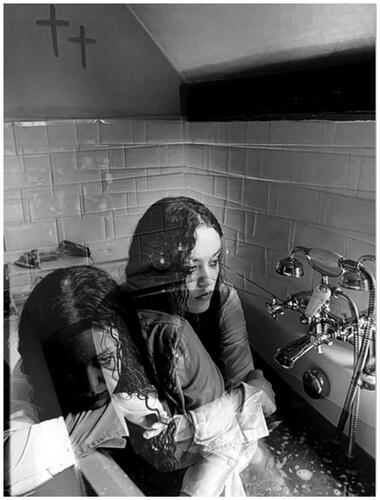
The artist’s composition, use of lighting and double exposure presents an apt use of photography in exploring a patient’s ‘seemingly numb and reticent’ stance whilst enduring debilitating periods. Peer comments address potential societal/cultural stigma around the open discussion of conditions specific to women and advocate the normalisation of these visceral, lived experiences.
The art of the patient narrative https://outofourheads.net/2018/10/28/the-art-of-the-patient-narrative/
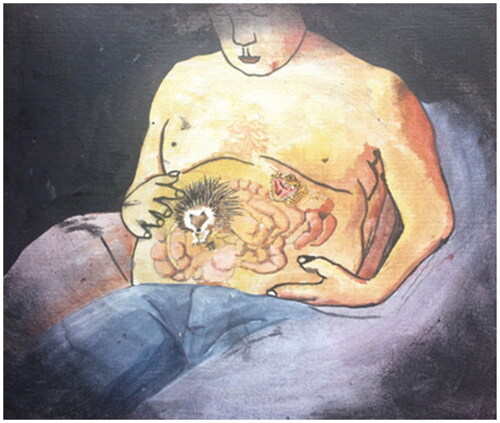
A patient’s imaginative metaphor for colitis inspired this artist to explore frustration around the ‘invisible’ interior body and the clinician’s responsibility in adapting verbal communication. Peer responses to the sensitive depiction of this patient’s narrative highlights the complexities of the relationship between body/mind and the illuminating potential of metaphors within consultations.
Deep cleanse https://outofourheads.net/2022/11/06/deep-cleanse/
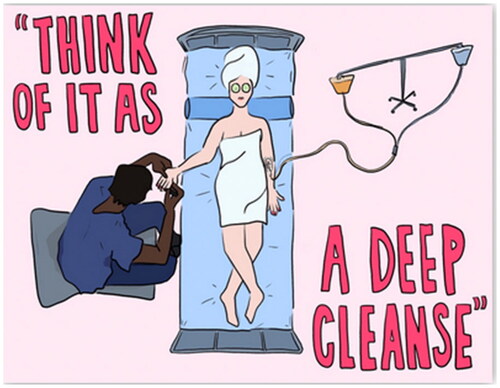
The alchemy of perfectly judged words which convey deep listening and transformative potential is pulled off with great originality in this example of graphic medicine. The complex and fluid body identity in ill-health is central to this composition informing the patient’s spa visualisation, yet healthcare is literally at hand.
I fixed his clock https://outofourheads.net/?s=clock
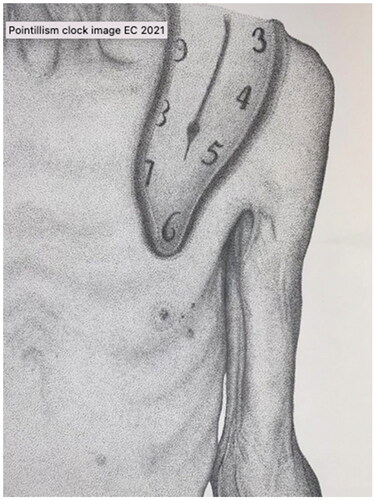
An elderly patient becomes the focus of this artist’s reflection on the nature of hospital time… measured and laid bare through pointillism. Informal companionship and spontaneous acts of kindness such as bringing life back to a familiar clock, exemplify the unquantifiable value of authentic care alongside a patient’s clinical journey.
Paranoia https://outofourheads.net/2010/10/30/paranoia/
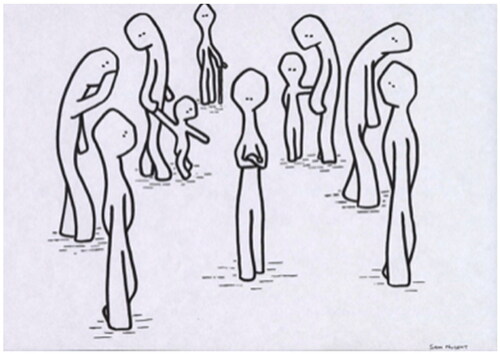
The artist’s interpretation of social dis-ease following a life-altering diagnosis is minimal in form and carefully choreographed. Inspired by insights from the play ‘Cancer Tales’, peers suggest the ‘folded arms’ and lowered eyes of the main character indicate a downward spiral of alienation from a crowd – nonetheless oblivious to this central figure’s fracturing selfhood.
Lost identity https://outofourheads.net/2020/09/18/lost-identity-megan-c/
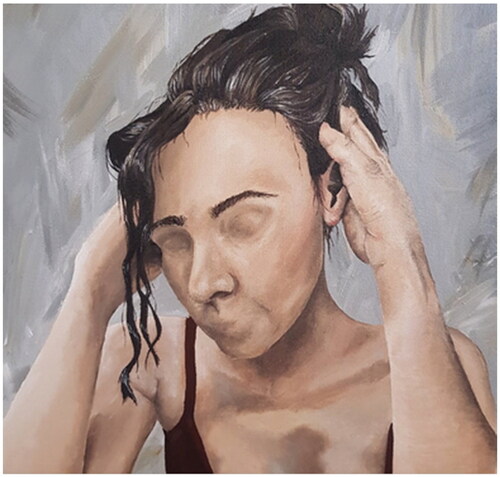
An arrestingly corporeal representation of a carers’ fading sense of self. We are drawn into the artist’s subtle painting-out of gaze, voice and facial expression in service of ‘bettering another’s quality of life’. A peer observation draws parallels with healthcare staff who habitually compromise their own health by placing their patients first.
The wait https://outofourheads.net/2018/10/28/the-wait/
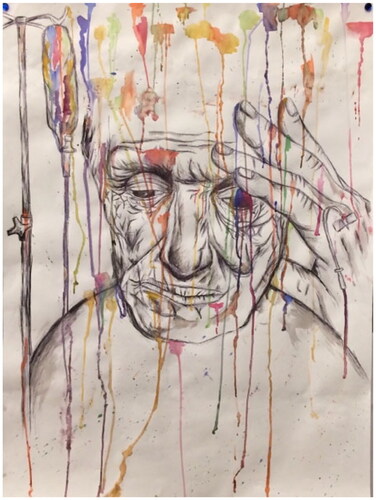
A collaborative enquiry exploring holistic support within end-of-life care, led to this poignant scratchy, portrait overlaid by dripping paint. Peer comments reflect how the artists’ use of media, bold composition and facial expression highlight the ill-timed ‘weight of decisions’ and ‘isolation’ often faced by patients in their final months of life.
Green space, deep breath https://outofourheads.net/2023/10/30/green-space-deep-breath/
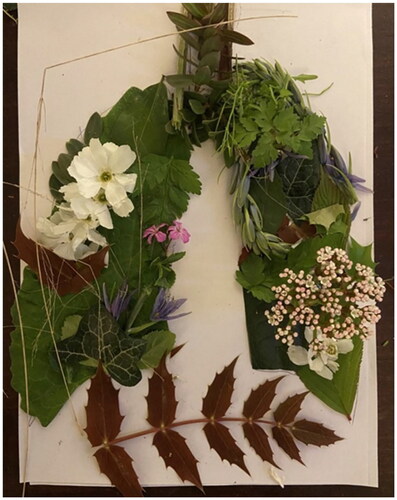
A patient’s belief that connection with nature provides the perfect conditions to support healing led to this considered botanical/anatomical materialisation. Whilst creatively honouring the affective aspects of this patient’s journey towards recovery the artist discovers an unexpected alignment and future resource to support well-being.
Love is blinding https://outofourheads.net/2020/10/22/love-is-blinding-saving-newborns-sight/
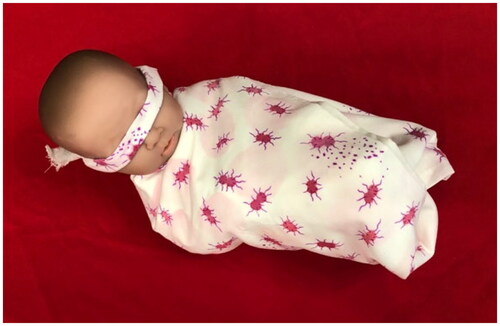
This engaging and deceptively simple, swaddled and blindfolded doll powerfully embodies the devastating impact of lack of information and stigma surrounding sexual health. A bedsheet, colourfully printed with a magnified image of the gonorrhoea bacteria, constricts the newborn and provides a grounded, chilling link between conception and potential childhood blindness.
Sell-by date https://outofourheads.net/2022/11/05/sell-by-date/
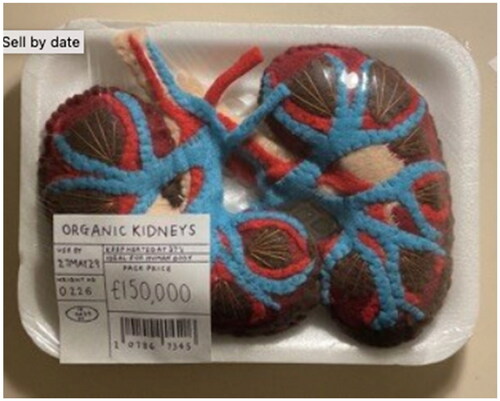
A patient’s throw-away remark around their kidney dis-function led the artist to anatomically represent her organs in wools and felts. The imagination and skills employed in representing these exquisite forms, then packaged as generic cuts of meat, inspired peers to muse further on the interconnected or fragmented body, organ donation and diverse cultural perspectives.
Heart in your hands https://outofourheads.net/2018/10/28/heart-in-your-hands/
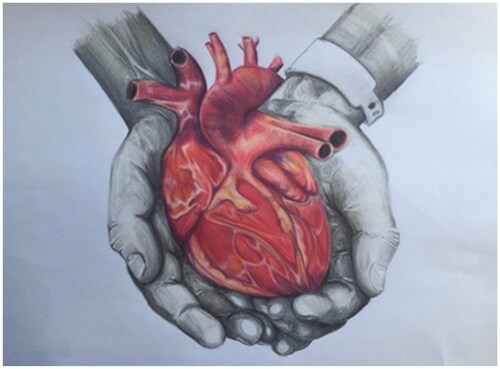
The palpable vulnerability of this offering is exquisitely rendered and honours patients’ surrender of narratives, body and soul. One peer response draws strength from the liminal positioning depicted suggesting ‘when the time is right, you will be a good doctor and you will be deserving of the trust a patient places in you.’
Sleep https://outofourheads.net/2020/10/22/sleep/
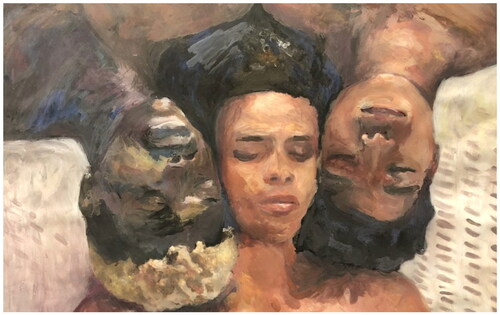
Dedication, mutual concern and vulnerability are bedfellows in this unique, tender configuration. The depth of reflection in peer comments - mostly in the first months of their course is a testament to both the catalyst of aesthetic engagement and what the breadth of humanity these young people offer to future medical practice.
The NHS is the closest thing the English have to a religion https://outofourheads.net/2022/11/05/the-nhs-is-the-closest-thing-the-english-have-to-a-religion/
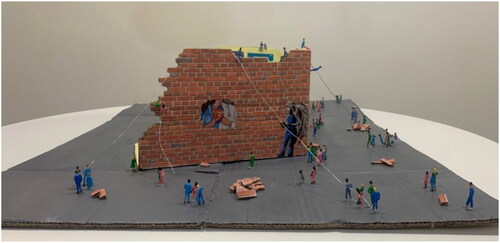
This 360% insight into conflicting medical, socio-emotional, political and community perspectives starkly critiques sustainability in the current NHS. The artists’ extraordinary quality of attention and time evident in the choice of materials, scale and positioning of each element mirrors the practical and imaginative ‘toil’ of unseen NHS staff literally holding up crumbling walls – poignantly plastered with posters of patient gratitude…
The creative curriculum
Through embedding creative opportunities within our undergraduate medical curriculum, our students gain a unique perspective on the art of medicine. They gain insight and agency, not only as observers, but as creators within the medical enterprise. A small but significant cadre of students expand their artistic portfolios far beyond the expectations of the formal curriculum. For instance OutOfOutHeads.net hosted a student-driven exhibition on the experience of learning medicine during the pandemic. Our staff continue to build experience in using creative enquiry as a means of delivering attitudinal learning and promoting wellbeing – for instance in our final year “Outside the Box” project. Works on the OOOHs website are principally by Bristol students. We are now encouraging external submissions from the wider healthcare community to OOOH’s evolving archive and exhibition programme. Individuals interested in learning more about the website or wishing to make a submission are warmly invited to contact the authors for more information.
Authors’ contributions
We confirm that this manuscript and curation of artwork has not been published before in this format and is not currently being considered for publication elsewhere. Creative works have been curated from outofourheads.net. TT wrote the initial draft of the narrative for the paper. All authors contributed to the choice of creative works for this collection. CL curated the creative works and added the summaries for each of the pieces. All authors worked collaboratively to edit and critically revise the paper. All authors have approved the final submitted version and agree to be accountable for all aspects of the work.
Ethical approval
Formal ethical approval was not required for this manuscript, however consent to republish the creative works was gained from all of the student artists. The identity of the patients who inspired some of this work has been rigorously anonymised.
Acknowledgements
The authors would like to acknowledge all of the students at the University of Bristol Medical School who participate in the creative components of the course and whose work highlights the fantastic integration of art and science within medicine.
Disclosure statement
None of the authors have conflicts of interests to declare with respect to the contents of this manuscript.
References
- Katz, J. T., & Khoshbin, S. (2014). Can visual arts training improve physician performance? Transactions of the American Clinical and Climatological Association, 125, 331–342.
- Scott, A., Sudlow, M., Shaw, E., & Fisher, J. (2020). Medical education, simulation and uncertainty. The Clinical Teacher, 17(5), 497–502. https://doi.org/10.1111/tct.13119
- Tan, C. Y., Chuah, C. Q., Lee, S. T., & Tan, C. S. (2021). Being creative makes you happier: The positive effect of creativity on subjective well-being. International Journal of Environmental Research and Public Health, 18(14), 7244. https://doi.org/10.3390/ijerph18147244
- Ten Haven, A., Pragt, E., Luijk, S. J., van Dolmans, D. H. J. M., & van Mook, W. N. K. A. (2022). Creativity: A viable and valuable competency in medicine? A qualitative exploratory study. Medical Teacher, 44(10), 1158–1164. https://doi.org/10.1080/0142159X.2022.2072278
- Thompson, T., Grove, L., Brown, J., Buchan, J., Kerry, A. L., & Burge, S. (2021). COGConnect: A new visual resource for teaching and learning effective consulting. Patient Education and Counseling, 104(8), 2126–2132. https://doi.org/10.1016/j.pec.2020.12.016
- Thompson, T., Lamont-Robinson, C., & Younie, L. (2010). Compulsory creativity’: Rationales, recipes, and results in the placement of mandatory creative endeavour in a medical undergraduate curriculum. Medical Education Online [Internet], 15(1). http://med-ed-online.net/index.php/meo/article/view/5394
- Thompson, T., van de Klee, D., Lamont-Robinson, C., & Duffin, W. (2010). Out of our heads! Four perspectives on the curation of an on-line exhibition of medically themed artwork by UK medical undergraduates. Medical Education Online, 15(1), 5395. https://doi.org/10.3402/meo.v15i0.5395

